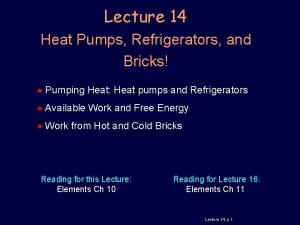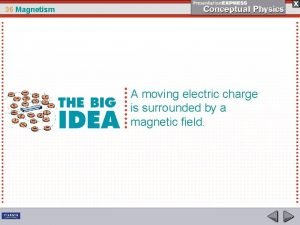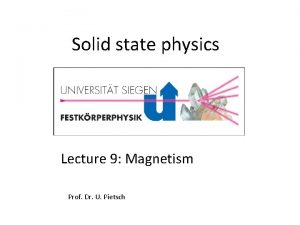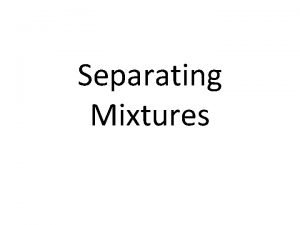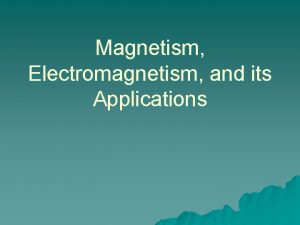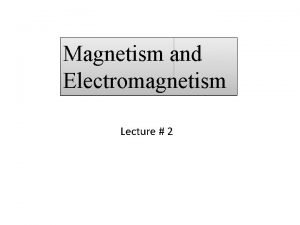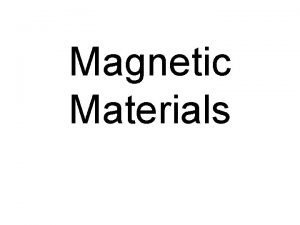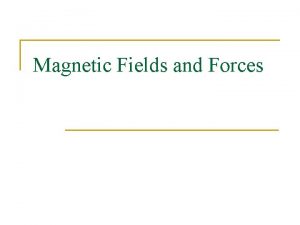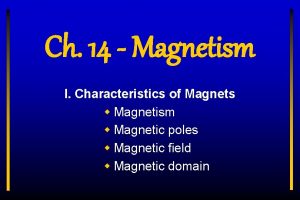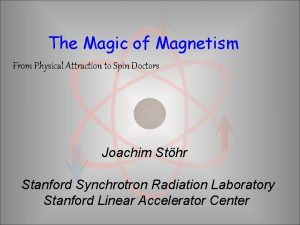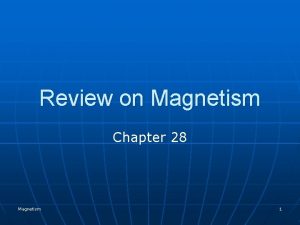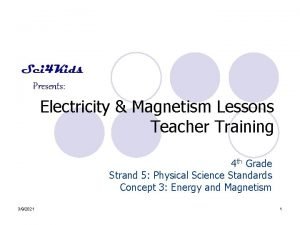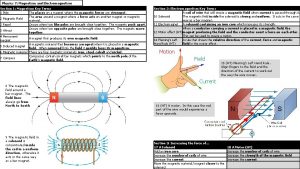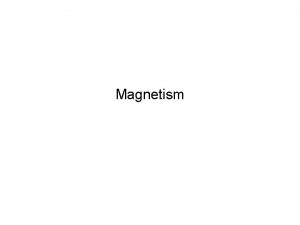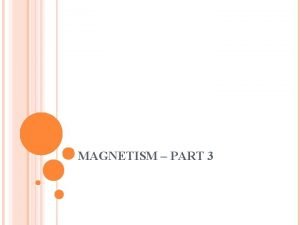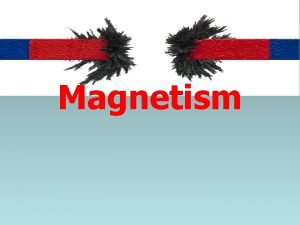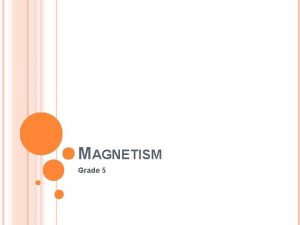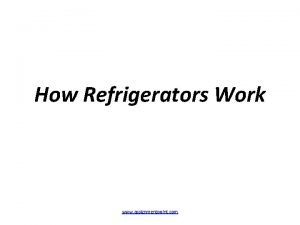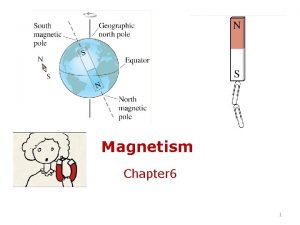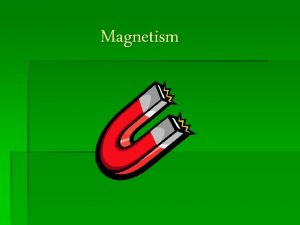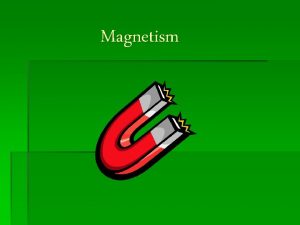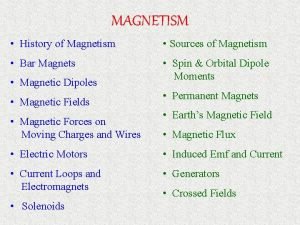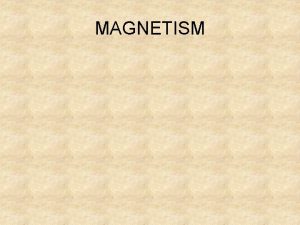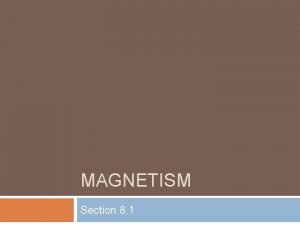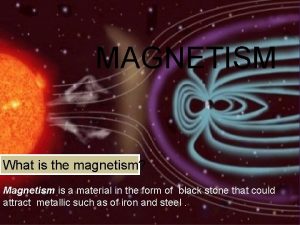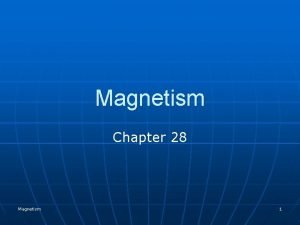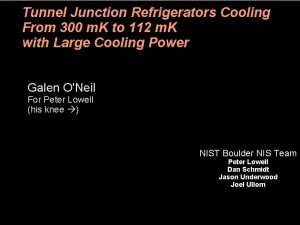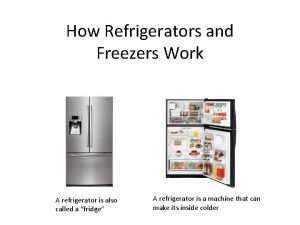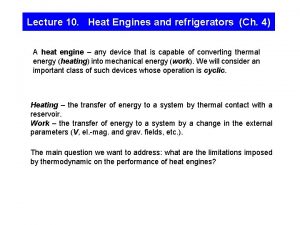Magnetism Chapter 28 Magnetism 1 Magnetism Refrigerators are



































- Slides: 35

Magnetism Chapter 28 Magnetism 1

Magnetism • Refrigerators are attracted to magnets! Magnetism 2

Where is Magnetism Used? ? • Motors • Navigation – Compass • Magnetic Tapes – Music, Data • Television – Beam deflection Coil • Magnetic Resonance Imaging (MRI) • High Energy Physics Research Magnetism 3

(28 – 8) Cathode Anode Magnetism 4

Consider a Permanent Magnet N S The magnetic Field B goes from North to South. Magnetism 5

Units Magnetism 6

Typical Representation Magnetism 7

A Look at the Physics q There is NO force on a charge placed into a magnetic field if the charge is NOT moving. There is no force if the charge moves parallel to the field. q • If the charge is moving, there is a force on the charge, perpendicular to both v and B. F = q v x B Magnetism 8

The Lorentz Force This can be summarized as: F or: v B mq q is the angle between B and V Magnetism 9

Nicer Picture Magnetism 10

The Wire in More Detail Assume all electrons are moving with the same velocity vd. L B out of plane of the paper Magnetism 11

(28 – 12) . i Magnetism 12

Current Loop What is force on the ends? ? Loop will tend to rotate due to the torque the field applies to the loop. Magnetism 13

Magnetic Force on a Current Loop F=BIL F L N Magnetism S B F I F=BIL 14

Magnetic Force on a Current Loop Simplified view: F=BIL L d I Magnetism F=BIL 15

Magnetic Force on a Current Loop Torque & Electric Motor Simplified view: F=BIL L d I Magnetism F=BIL 16

Magnetic Force on a Current Loop Torque & Electric Motor F=BIL L Magnetism I for a current loop d F=BIL 17

(28 – 13) Side view Top view C C Magnetism 18

Magnetic Force on a Current Loop Torque & Magnetic Dipole By analogy with electric dipoles, for which: The expression, implies that a current loop acts as a magnetic dipole! Here is the magnetic dipole moment, and Magnetism (Torque on a current loop)19

Dipole Moment Definition Define the magnetic dipole moment of the coil m as: m=Ni. A t=m x B Magnetism We can convert this to a vector with A as defined as being normal to the area as in the previous slide. 20

Magnetism 21 (28 – 14)

R L L Magnetism L R R 22 (28 – 15)

Motion of a charged particle in a magnetic Field Magnetism 23

Trajectory of Charged Particles in a Magnetic Field (B field points into plane of paper. ) + +B + v+ + + + + F + + + + + + B + + + Magnetism v 24

Trajectory of Charged Particles in a Magnetic Field (B field points into plane of paper. ) v+ + B + +B + v + + + F + + + + + + Magnetism Magnetic Force is a centripetal force 25

Review of Rotational Motion = s / r s = r ds/dt = d /dt r v = r s r = angle, = angular speed, = angular acceleration at ar at = r tangential acceleration ar = v 2 / r radial acceleration The radial acceleration changes the direction of motion, while the tangential acceleration changes the speed. Uniform Circular Motion ar = constant v and ar constant but direction changes v Magnetism ar = v 2/r = 2 r KE = ½ mv 2 = ½ mw 2 r 2 F = mar = mv 2/r = m 2 r 26

Radius of a Charged Particle Orbit in a Magnetic Field +B + v+ + + r + + + Magnetism F Centripetal Magnetic = Force Force 27

Cyclotron Frequency +B + v + + + r + + + Magnetism F + The time taken to complete one orbit is: 28

Mass Spectrometer Smaller Mass Magnetism 29

Magnetism 30

An Example A beam of electrons whose kinetic energy is K emerges from a thin-foil “window” at the end of an accelerator tube. There is a metal plate a distance d from this window and perpendicular to the direction of the emerging beam. Show that we can prevent the beam from hitting the plate if we apply a uniform magnetic field B such that Magnetism 31

Problem Continued r Magnetism 32

#14 Chapter A metal strip 6. 50 cm long, 0. 850 cm wide, and 0. 760 mm 28 thick moves with constant velocity through a uniform magnetic field B= 1. 20 m. Tdirected perpendicular to the strip, as shown in the Figure. A potential difference of 3. 90 ηV is measured between points x and y across the strip. Calculate the speed v. FIGURE 2837 Magnetism Problem 14. 33

n 21. (a) Find the frequency of revolution of an electron with an energy of 100 e. V in a uniform magnetic field of magnitude 35. 0 µT. (b) Calculate the radius of the path of this electron if its velocity is perpendicular to the magnetic field. Magnetism 34

n 39. A 13. 0 g wire of length L = 62. 0 cm is suspended by a pair of flexible leads in a uniform magnetic field of magnitude 0. 440 T. What are the (a) magnitude and (b) direction (left or right) of the current required to remove the tension in the supporting leads? Magnetism 35
 Insidan region jh
Insidan region jh Refrigerators the brick
Refrigerators the brick Chapter 24 magnetism magnetic fundamentals answers
Chapter 24 magnetism magnetic fundamentals answers Chapter 36 magnetism answer key
Chapter 36 magnetism answer key Physics 102 electricity and magnetism
Physics 102 electricity and magnetism Ib physics topic 5
Ib physics topic 5 Magnetism love
Magnetism love Magnetism
Magnetism Magnet to separate a mixture
Magnet to separate a mixture Electricity and magnetism lecture notes
Electricity and magnetism lecture notes Hans christian oersted magnetism
Hans christian oersted magnetism Is magnetism an invisible force
Is magnetism an invisible force Magnetism is an invisible
Magnetism is an invisible Magnetism and electromagnetism
Magnetism and electromagnetism Artificial magnet example
Artificial magnet example Circular magnetism
Circular magnetism Magnetic flux units
Magnetic flux units Magnetismn
Magnetismn Equation of continuity in electromagnetism
Equation of continuity in electromagnetism Lisa exposes an iron paper clip to a very strong magnet
Lisa exposes an iron paper clip to a very strong magnet Electricity jeopardy
Electricity jeopardy Characteristic of magnetism
Characteristic of magnetism Magnetism
Magnetism Sph3u electricity and magnetism
Sph3u electricity and magnetism Magnetism
Magnetism Basics of magnetism
Basics of magnetism Magnetism and electromagnetism
Magnetism and electromagnetism Relationship between electricity and magnetism
Relationship between electricity and magnetism The phenomenon of magnetism is best understood in terms of
The phenomenon of magnetism is best understood in terms of Magnetism
Magnetism Nature of magnetism
Nature of magnetism Intensity of magnetisation
Intensity of magnetisation Magnetism grade 5
Magnetism grade 5 Confidential
Confidential Scrap heap magnet circuit diagram
Scrap heap magnet circuit diagram Hysteresis loop magnetism
Hysteresis loop magnetism

